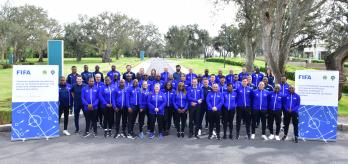Injuries suffered as a youngster can have a long-term impact on a footballer’s career, and teenagers going through the adolescent growth spurt are particularly vulnerable to growth-related injuries, as well as conditions like Osgood-Schlatter’s Disease and Sever’s Disease. This study by Dr David Johnson and his colleagues used data from 49 elite teenage players over two seasons to better understand which injuries they were most likely to suffer before testing a number of different strategies for mitigating injury risk.
Key take-aways
-
Growth and maturation are not the same thing. Youngsters mature at different rates, which can affect their development as footballers and the injuries they are most likely to suffer.
-
Players in the adolescent growth spurt are particularly vulnerable to certain injuries.
-
This injury risk can be mitigated by a range of measures, from better monitoring of physical development to changing training regimes and applying specific injury prevention protocols.
Watch brief
Read summary
Part 1: Growth, maturation and injuries in youth football
The first section of the presentation explains some of the key terminology behind the study, The distinction between growth and maturation is particularly important, as is the fact that youngsters go through the adolescent growth spurt at different times; this variation can have a significant influence on their development on the pitch. Dr Johnson also highlights some of the most common injuries seen in young players, such as Sever’s Disease and Osgood-Schlatter’s disease, and when they are most likely to occur.
Part 2: Study methodology and conclusions
Dr Johnson then moves on to describe how the researchers collected data on growth-related injuries in young players, and calculated that players who were between 88% and 92% of their predicted full height and growing fast were at highest risk of injury. To address this risk, they introduced improved monitoring, tailored training and a greater focus on balance and coordination work, which led to a significant reduction in injuries affecting the players most at risk. Clubs might consider introducing similar measures to reduce the risk of injuries in their academies, as well as specific injury prevention protocols for key age groups.
Paper citation
Johnson, D., Williams, S., Bradley, B, Cumming, Sean P., 2021, “Can we reduce injury risk during the adolescent growth spurt? An iterative sequence of prevention in male academy footballers”, Annals of Human Biology 2021, vol. 50 no. 1, pp. 452 – 460
Read the full paper here.











